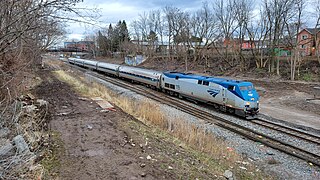
The Maple Leaf is an international passenger train service operated by Amtrak and Via Rail between New York Penn Station in New York City and Union Station in Toronto via Amtrak's Empire Corridor, and the south western part of Via Rail's Quebec City–Windsor Corridor. Daily service is offered in both directions; the 544-mile (875 km) trip takes approximately 12 hours, including two hours for U.S. or Canadian customs and immigration inspection at either Niagara Falls, New York, or Niagara Falls, Ontario. Although the train uses Amtrak rolling stock exclusively, the train is operated by Via Rail crews while in Canada and by Amtrak crews in the United States. Service began in 1981.
The Lehigh Valley Railroad was a railroad in the Northeastern United States built predominantly to haul anthracite coal from the Coal Region in Northeastern Pennsylvania to major consumer markets in Philadelphia, New York City, and elsewhere.
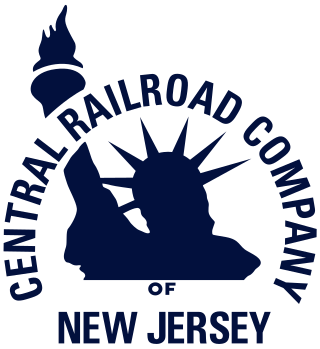
The Central Railroad of New Jersey, also known as the Jersey Central, Jersey Central Lines or New Jersey Central, was a Class I railroad with origins in the 1830s. It was absorbed into Conrail in April 1976 along with several other prominent bankrupt railroads of the Northeastern United States.

The Lehigh Line Connection connects Amtrak's Northeast Corridor (NEC) with the Conrail Lehigh Line 2 miles (3.2 km) south of downtown Newark, New Jersey. It leaves the NEC at Hunter Interlocking, and the line is sometimes called the Hunter Connection. Used by New Jersey Transit (NJT) Raritan Valley Line trains since 1997 when it replaced an older connection, it splits from the NEC just north of the former connector, with wider radius curves with a maximum speed of 45 mph, compared to the 15 mph of the original alignment.

For the purposes of this article, the Jersey City area extends North to Edgewater, South to Bayonne and includes Kearny Junction and Harrison but not Newark. Many routes east of Newark are listed here.

The Raritan Valley Line is a commuter rail service operated by New Jersey Transit (NJT) which serves passengers in municipalities in Union, Somerset, Middlesex, Essex, and Hunterdon counties in the Raritan Valley region, primarily in central New Jersey and a smaller portion of northern New Jersey, in the United States. The line's most frequent western terminus is Raritan station in Raritan. Some weekday trains continue farther west and terminate at the High Bridge station, located in High Bridge. Most eastbound trains terminate in Newark; passengers are able to transfer to NJ Transit using a combined ticket or PATH and Amtrak to New York City. A limited number of weekday trains continue directly to New York.

The Aldene Connection is a connection between two railroad lines in the Aldene neighborhood of Roselle Park, New Jersey, United States, one formerly belonging to the Central Railroad of New Jersey (CNJ), the other formerly of the Lehigh Valley Railroad. The connections allow trains on the New Jersey Transit Raritan Valley Line to travel from Cranford and points west through stations in Roselle Park and Union to the Hunter Connection in Newark, which in turn allows access to the Northeast Corridor and Newark Penn Station.

The Lehigh and Hudson River Railway (L&HR) was the smallest of the six railroads that were merged into Conrail in 1976. It was a bridge line running northeast–southwest across northwestern New Jersey, connecting the line to the Poughkeepsie Bridge at Maybrook, New York, with Easton, Pennsylvania, where it interchanged with various other companies.
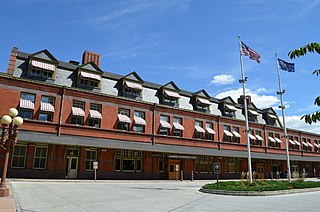
The Harrisburg Transportation Center is a railway station and transportation hub in Harrisburg, Pennsylvania. It is located on the eastern edge of Downtown Harrisburg between the intersections of Aberdeen and Market Streets and 4th and Chestnut Streets.
North Pennsylvania Railroad was a railroad company which served Philadelphia, Montgomery County, Bucks County and Northampton County in Pennsylvania. It was formed in 1852, and began operation in 1855. The Philadelphia and Reading Railway, predecessor to the Reading Company, leased the North Pennsylvania in 1879. Its tracks were transferred to Conrail and the Southeastern Pennsylvania Transportation Authority (SEPTA) in 1976.
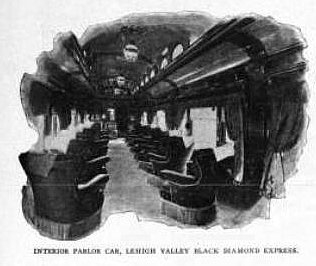
The Black Diamond, also known as the Black Diamond Express, was the flagship passenger train of the Lehigh Valley Railroad (LV). It ran from New York to Buffalo from 1896 until May 11, 1959, when the Lehigh Valley's passenger service was reduced to four mainline trains.

The Reading Blue Mountain and Northern Railroad, sometimes shortened to Reading and Northern Railroad, is a regional railroad in eastern Pennsylvania. With a headquarters in Port Clinton, the RBMN provides freight service on over 400 miles (640 km) of track. Its mainline consists of the Reading Division between Reading and Packerton and the Lehigh Division between Lehighton and Dupont. This mainline gives the RBMN a direct route from Reading to Scranton, the first such route to exist under the control of a single railroad. Founded in 1983 to take over from Conrail on the ex-Pennsylvania Railroad Schuylkill Branch between Reading and Hamburg, the railroad quickly grew over the next several decades to become the largest privately-owned Class II railroad in the United States. Its main freight cargo is anthracite coal, but also sees significant shipments in frac sand, forest products, petrochemicals and minerals, food and agricultural products, metals, and consumer products.

The Crusader was a 5 car stainless steel streamlined express train that ran on a 90.3-mile (145.3 km) route from Philadelphia's Reading Terminal to Jersey City's Communipaw Terminal, with a ferry connection to Lower Manhattan at Liberty Street. The Reading Railroad provided this service in partnership with the Central Railroad of New Jersey (CNJ), in which it was the majority owner of capital stock. Trains including the Crusader ran on Reading Railroad tracks from Reading Terminal in Philadelphia to Bound Brook, NJ, where they continued on CNJ tracks to Communipaw Terminal in Jersey City. Passengers then left the train and walked aboard the ferry or boarded busses that loaded onto the ferry. Introduced in 1937, the Crusader service declined during the 1960s, and the name was ultimately dropped in 1981.

Duryea Yard is a railroad yard in the Wyoming Valley region of Northeastern Pennsylvania currently operated by the Reading Blue Mountain and Northern Railroad. Originally constructed in 1870 by Lehigh Valley Railroad as a turn-around and staging hub for coal transport from the Coal Region to Eastern big-city markets, the yard remains a hub for the energy extraction industry today.
The Danville, Hazleton and Wilkes-Barre Railroad, also called the D.H. & W.B. Railroad, was a railroad in northeastern Pennsylvania. It ran from Sunbury to Tomhicken, a total of 43.44 miles plus 10.1 miles of branch lines, making the whole railroad 53.54 miles long. The railroad was completed in 1870. As of 2010, the Danville, Hazleton and Willkes-Barre Railroad tracks belong to the Pennsylvania Railroad. The railroad's gauge was 4 ft 9 in.

The Lehigh Line is a railroad line in Central New Jersey, Northeastern Pennsylvania, and the Lehigh Valley region of eastern Pennsylvania. It is owned and operated by the Norfolk Southern Railway. The line runs west from the vicinity of the Port of New York and New Jersey in Manville, New Jersey via Conrail's Lehigh Line to the southern end of Wyoming Valley's Coal Region in Lehigh Township, Pennsylvania.

Bethlehem Union Station is a former train station located in the South Side neighborhood of Bethlehem, Pennsylvania. It was built in 1924 by the Lehigh Valley Railroad and the Reading Company, replacing an earlier station built in 1867. Passenger service to Philadelphia on the SEPTA Regional Rail Bethlehem Line lasted until 1981. The station was renovated in 2002 and used for medical clinics beginning in 2003. It is owned by St. Luke's Hospital.
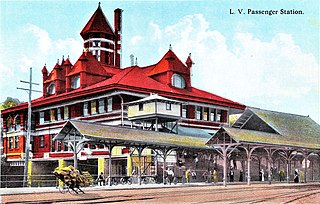
Allentown was a train station in Allentown, Pennsylvania. It was opened by the Lehigh Valley Railroad in 1890 and closed in 1961. The building was demolished in 1972. The station was located one block west of the Central Railroad of New Jersey's Allentown station.
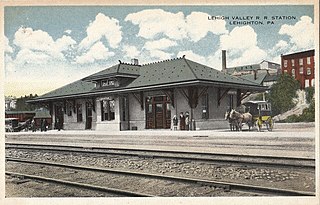
Lehighton station was a Lehigh Valley Railroad station that was located in Lehighton, Pennsylvania, USA. It was part of the Lehigh Valley main line, and was also the eastern terminus for Hazleton Branch passenger trains, although the branch diverged at Penn Haven Junction, north of Jim Thorpe.
The Maple Leaf was an international night train between New York City and Toronto, operated by the Lehigh Valley Railroad in coordination with the Canadian National Railway. It ran from Penn Station in New York City and concluded at Toronto's Union Station. The train's service began in 1937; a predecessor Lehigh Valley Railroad train, the Toronto, traveled the same route. The Maple Leaf and the John Wilkes were the last named passenger trains operated by the Lehigh Valley Railroad.
















